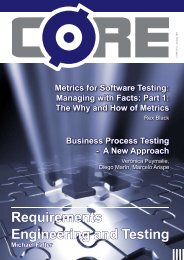Comparison of Change Management Systems
Comparison of Change Management Systems
Comparison of Change Management Systems
Create successful ePaper yourself
Turn your PDF publications into a flip-book with our unique Google optimized e-Paper software.
06<br />
<strong>Management</strong><br />
Agile s<strong>of</strong>tware<br />
development with<br />
distributed teams<br />
basic<br />
intermediate<br />
advanced<br />
About the author:<br />
Jutta Eckstein is an independent<br />
coach, consultant and trainer from<br />
Braunschweig, Germany. Her know-how<br />
in agile processes is based on over ten<br />
years experience in developing objectoriented<br />
applications.<br />
She has helped many teams and<br />
organizations all over the world to make<br />
the transition to an agile approach. She<br />
has a unique experience in applying<br />
agile processes within medium-sized to<br />
large distributed mission-critical projects.<br />
This is also the topic <strong>of</strong> her books ‘Agile<br />
S<strong>of</strong>tware Development in the Large’<br />
and ‘Agile S<strong>of</strong>tware Development with<br />
Distributed Teams’. She is a member <strong>of</strong><br />
the AgileAlliance and a member <strong>of</strong> the<br />
program committee <strong>of</strong> many different<br />
European and American conferences in<br />
the area <strong>of</strong> agile development, objectorientation<br />
and patterns.<br />
Understanding Agility<br />
A historic marker indicating that agile<br />
methods no longer would be considered<br />
mere hype or a fringe movement was<br />
Scott Adams’ Dilbert comic strip on agility 1<br />
. With every passing year, agile concepts<br />
have become more firmly ent renched<br />
in mainstream business and, today, are<br />
largely accepted in the modern market. Of<br />
course, while noting the movement <strong>of</strong> agile<br />
methods from the realm <strong>of</strong> fringe, Adams<br />
also exposes typical misunderstandings,<br />
illformed expectations, and downright<br />
strange interpretations that some think<br />
still pervade the agile approach.<br />
Agility has come into its own as a value<br />
system defined by the Agile Manifesto 2<br />
. Based on twelve principles created<br />
to ensure the value system 3 , the Agile<br />
Manifesto demonstrates that there is<br />
more to agile development than just one<br />
specific methodology, such as Extreme<br />
Programming 4 or Scrum 5 .<br />
The first value stated in the manifesto<br />
favors “individuals and interactions over<br />
processes and tools.” The processes<br />
referenced in this first value statement<br />
include agile development processes,<br />
which means teams must ensure that<br />
their development process supports their<br />
needs in the best way possible. Using<br />
the principles in the manifesto, teams<br />
can find guidance on how to modify and<br />
adjust their development processes to<br />
best support their needs.<br />
Core Value Pair Statements<br />
The values expressed in the Agile<br />
Manifesto apply to all agile projects,<br />
superceding guidelines <strong>of</strong> any specific<br />
agile process. The core <strong>of</strong> the manifesto<br />
compares in four statements two values<br />
and argues that although each value<br />
provides a value in general, the first value<br />
is more important than the second and<br />
Author: Jutta Eckstein<br />
that the latter half <strong>of</strong> the each statement<br />
is only valid if it supports the former.<br />
• Value Pair Statement #1, “Individuals<br />
and interactions over processes and<br />
tools,” highlights the idea that it is always<br />
the people involved in a project and how<br />
they collaborate that determine a project’s<br />
success or failure. The manifesto does not<br />
devalue processes and tools (otherwise,<br />
we wouldn’t talk about processes, and<br />
the agile community wouldn’t have<br />
created tools such as unit-testing<br />
frameworks, integration and configuration<br />
management tools, and others), but if<br />
individuals don’t work together as a team,<br />
the best tools and processes won’t help<br />
the project succeed.<br />
• Value Pair Statement #2, “Working<br />
s<strong>of</strong>tware over comprehensive<br />
documentation,” is perhaps the most<br />
<strong>of</strong>ten misunderstood <strong>of</strong> the four<br />
statements. People unfamiliar with agile<br />
development may mistakenly believe<br />
agile projects don’t document, or even<br />
disdain documentation. Not so. In the<br />
same way that processes and tools play<br />
a major role in successful development,<br />
documentation also plays a major<br />
role. However, this value comparison<br />
expresses that working s<strong>of</strong>tware is the<br />
critical success factor for any development<br />
effort. Documentation might be needed<br />
to support or to understand the working<br />
s<strong>of</strong>tware, but it can’t and shouldn’t be an<br />
end in itself.<br />
• Value Pair Statement #3, “Customer<br />
collaboration over contract negotiation,”<br />
emphasizes that although you need a<br />
contract, it can never be a substitute for<br />
a good relationship with your customer.<br />
In order to deliver a satisfactory product,



